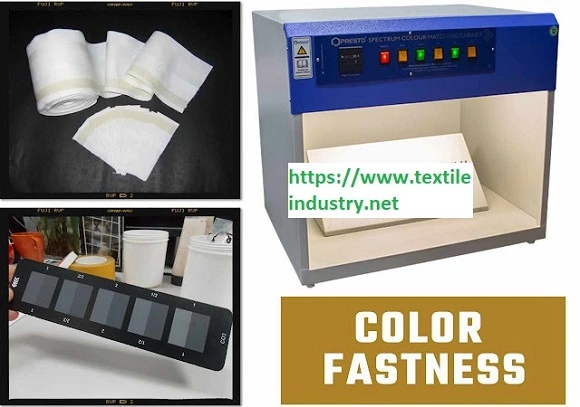What is the Color Fastness Test in Textile Fabric? Definition, Meaning, and Types
Color Fastness is an important consideration in the production of textiles, clothing, and fabrics, as well as in the printing and dyeing industries. Testing for colorfastness is typically performed using standardized methods to ensure consistent and reliable results.
Color fastness is a term used to describe the ability of a fabric or other material to resist color fading or transfer. Various types of color fastness tests are performed to determine the color quality and durability of fabrics. The term is commonly used to refer to clothing. In general, clothing should be tested for color before using bleach or other cleaning products.
What is Color Fastness? Definition and Meaning
Colorfastness refers to the ability of a material or substance to retain its color when exposed to various environmental factors such as light, heat, water, and other chemicals. It is a measure of a material’s resistance to color fading, bleeding, or transfer to other materials.
Different types of color fastness tests can be performed depending on the specific requirements of the material or product, including tests for light fastness, washing fastness, cracking fastness, and perspiration fastness. Understanding color fastness is important to ensure the longevity and durability of materials and to prevent color transfer or fading.

Why is Color Fastness Important?
Colorfastness refers to the ability of a material or fabric to retain its color when exposed to various factors such as water, light, and washing. It is an essential factor in the textile and clothing industry as it affects the quality, durability, and appearance of the final product.
Color Fastness is Important For Several Reasons:
Aesthetics: Color is an important factor in the appearance of clothing and textiles. Consumers expect the colors of their clothing to remain consistent and vibrant over time, and poor color fastness can cause clothing to fade, bleed, or discolor.
Durability: Garments that lose color quickly are more likely to wear out quickly than fabrics with good color fastness. Therefore, fabrics with good color fastness have a longer life.
Quality: Color fastness is an indicator of quality. Fabrics and textiles that retain their color despite exposure to various environmental factors are considered to be of high quality.
Safety: Some dyes and pigments used in textiles can cause skin irritation and allergic reactions. Poor color fastness can result in the release of these dyes and pigments, making them potentially harmful to the wearer.
Types of Color Fastness
There are several types of color fastness to determine the quality and durability of the color of a fabric or material. Those are in the following:
- Color Fastness To Water
- Color Fastness To Washing
- Color Fastness To Perspiration
- Color Fastness To Crocking/Rubbing
- Color Fastness To Phenolic Yellowing
- Color Fastness To Light
- Color Fastness To Bleeding
- Color Fastness To Hot Pressing
- Color Fastness To Dye Transfer In Storage
- Color Fastness To Sea Water
- Color Fastness To Saliva
- Color Fastness To Chlorinated Water
- Color Fastness To Laundering
Assessment Of Color Fastness
There are three types of tests for color fastness:
- Change in Color: The difference in color between tested and untested specimens/products.
- Color Staining: How much the color stains a reference material such as multifibre adjacent fabric.
- Cross Staining: Stain within a product. From darker to lighter areas or details to the main material.
Assessment Of Color Fastness
Two technicians shall assess the test specimens. If they do not have the same assessment and a mean cannot be calculated (i.e. 3 &2-3) a third technician should be asked to assess the specimen. The median of the three individual assessments will then be the result. In cases where the result is a clear fail or pass a single technician’s evaluation is sufficient for the results.
Cross Staining & Change in Color
- Placed the tested specimen as well as the untested specimen on an inclined plane with an angle of approximately 45`C in the lightbox (D65 light).
- Assess the visual contrast between the tested specimen and the untested specimen against the grey scale. If the assessment is between two grades the result is to be reported as half grade, for example, 2-3.
Color Staining
- Place the tested specimen as well as the untested specimen on an inclined plane with an angle of approximately 45`C in the lightbox (D65 light).
- Assess the visual contrast between the tested multifibre fabric and the untested multifibre fabric against the greyscale, If the assessment is between two grades the result is to be reported as a half grade, for example, 2-3.
Conclusion
Overall, Colorfastness is critical to ensuring that textiles and apparel meet consumer expectations, have a long lifespan, are of high quality, and are safe to wear. It is the main quality testing parameter of any fabric. We all are using Fabric in clothes. This test result indicates how good and stable the dyeing and printing are in the Fabric.
- Additionally, You may love to read: Types of Garments Test in the Apparel Industry
- Types of Color Fastness Tests of Textile Fabric


